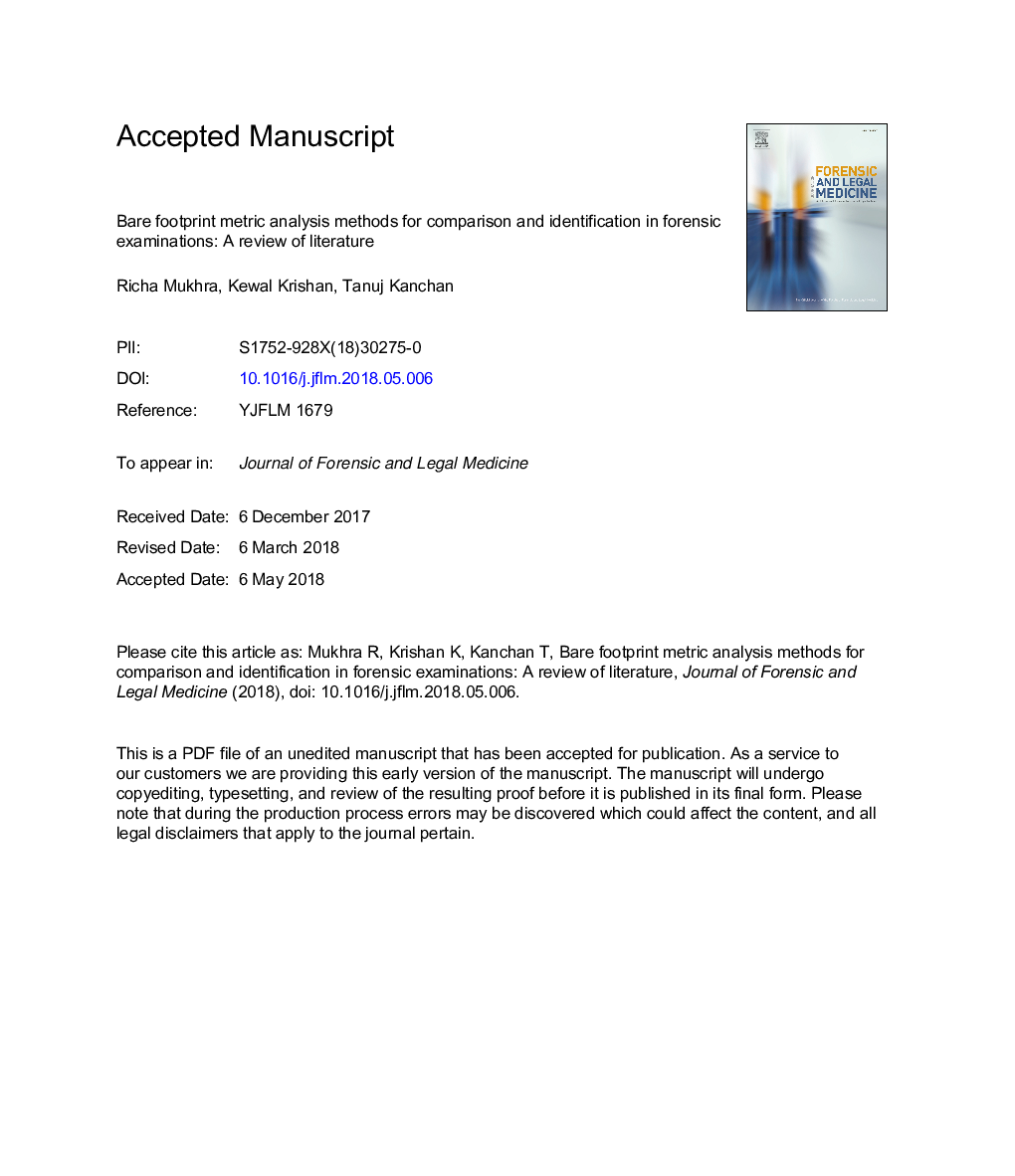| کد مقاله | کد نشریه | سال انتشار | مقاله انگلیسی | نسخه تمام متن |
|---|---|---|---|---|
| 6554887 | 1422412 | 2018 | 49 صفحه PDF | دانلود رایگان |
عنوان انگلیسی مقاله ISI
Bare footprint metric analysis methods for comparison and identification in forensic examinations: A review of literature
ترجمه فارسی عنوان
روش تجزیه و تحلیل متریک پنهان بر روی برای مقایسه و شناسایی در معاینات پزشکی قانونی: بررسی ادبیات
دانلود مقاله + سفارش ترجمه
دانلود مقاله ISI انگلیسی
رایگان برای ایرانیان
کلمات کلیدی
علم قضایی، مورفولوژی رد پا، پدیده پزشکی قانونی، روش های تجزیه و تحلیل ردپاها، رد پا ها، شناسایی شخصی،
ترجمه چکیده
رد پا یکی از شایعترین انواع شواهد فیزیکی است که در صحنه جرم شناخته شده است. شواهد پیمایشی قانونی ممکن است نقش مهمی در ایجاد هویت یک شخص داشته باشند؛ بنابراین معاینه آن اهمیت دارد. یک پیوند ممکن است با مشاهده و مقایسه ویژگی های مورفولوژیکی رد پا با مظنون ایجاد شود. این نسخه های چاپی پابرهنه ممکن است به عنوان یک چاپ دو بعدی یا یک اثر سه بعدی، بسته به نوع بستری که تحت تأثیر قرار گرفته اند، مطابق با روش های مختلف و روش های مختلف برای شناسایی چاپ چاپ شده مورد استفاده قرار گیرد. پس از اجرای روش مناسب، این چاپ ها با چاپ های نمونه چاپ شده، یعنی چاپ کردن مظنونین برای محدود کردن روند شناسایی، مقایسه می شود. تجزیه و تحلیل پدیده های بیهوده برای ارائه طیف گسترده ای از دانش در مورد الگوهای چاپ مختلف مورد استفاده قرار گرفته است. بنابراین، کار کنونی یک مرور کلی از روش ها و شاخص های مختلفی که برای ارزیابی رد پای مقایسه برای مقاصد مقایسه و شناسایی استفاده می شود را گسترش می دهد. ارزیابی و تفسیر رد پای ها نه تنها اهمیت اولیه در معاینه پزشکی است، بلکه همچنین در معاینه بالینی و درک اختلالات متداول متداول کمک می کند. این مقاله همچنین بر روی وقوع شواهد پدیده، آموزش پزشکی و آموزش پزشکی قانونی، قابلیت اطمینان و صحت روش های تجزیه و تحلیل ردیابی و اختلافات درون ریتم و تداخلات مرتبط متمرکز شده است.
موضوعات مرتبط
علوم زیستی و بیوفناوری
بیوشیمی، ژنتیک و زیست شناسی مولکولی
ژنتیک
چکیده انگلیسی
Footprint is one of the most common types of physical evidence recovered at a crime scene. The forensic footprint evidence may play an important role in establishing the identity of a person; therefore, its examination is of prime importance. A link may be established by observing and comparing the morphological features of footprints with the perpetrator. These barefoot prints may be present as a two-dimensional print or a three-dimensional imprint depending on the substrate upon which they have been impressed upon and accordingly different methods and techniques are implemented in order to identify the questioned prints. After the execution of appropriate procedure, these prints are then compared with the exemplar prints, i.e., prints of the suspects to narrow down the process of identification. The analysis of bare footprints has been used to offer a wide range of knowledge about different print patterns. Thus, the present work extends an overview of the different methods and indices that are being used to evaluate footprints for comparison and identification purposes. The evaluation and interpretation of footprints is not only of prime importance in forensic examination but also help in clinical examinations and elucidation of various podiatric disorders. The paper also focuses on the occurrence of footprint evidence, forensic podiatric training and education, reliability and accuracy of the footprint analysis methods and associated intra-rater and inter-rater discrepancies.
ناشر
Database: Elsevier - ScienceDirect (ساینس دایرکت)
Journal: Journal of Forensic and Legal Medicine - Volume 58, August 2018, Pages 101-112
Journal: Journal of Forensic and Legal Medicine - Volume 58, August 2018, Pages 101-112
نویسندگان
Richa Mukhra, Kewal Krishan, Tanuj Kanchan,
